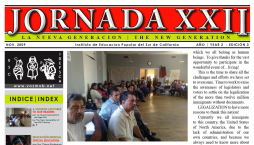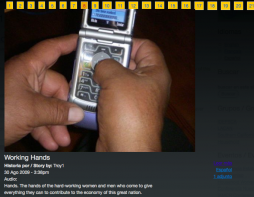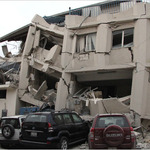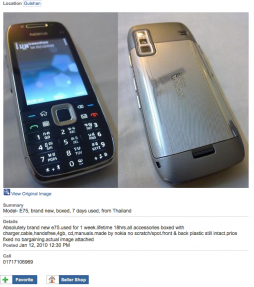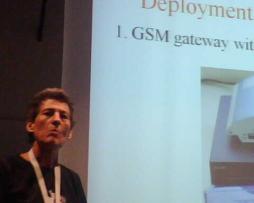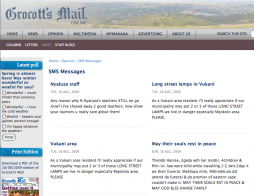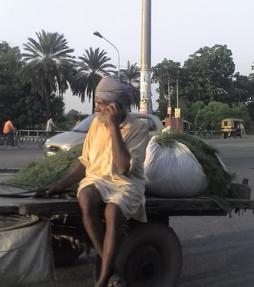Note: This is the second of two articles about Mobile Voices, a project based in Southern California. The first post can be found here.
Voces Móviles / Mobile Voices is a Los Angeles-based citizen media project, a collaboration between the Annenberg School for Communication at the University of Southern California (ASC) and the Institute of Popular Education of Southern California (IDEPSCA). Mobile Voices describes itself as "a platform for immigrant workers in Los Angeles to create stories about their lives and communities directly from cell phones. [The project] helps people with limited computer access gain greater participation in the digital public sphere."
Note: This is the first of two articles about Mobile Voices, a project based in Southern California.
Voces Móviles / Mobile Voices is a Los Angeles-based citizen media project, a collaboration between the Annenberg School for Communication at the University of Southern California (ASC) and the Institute of Popular Education of Southern California (IDEPSCA). Mobile Voices is "a platform for immigrant workers in Los Angeles to create stories about their lives and communities directly from cell phones. Vozmob helps people with limited computer access gain greater participation in the digital public sphere."
Relief efforts are ongoing after a powerful 7.0 earthquake that struck Haiti yesterday. Mobile phones play a huge part in relief efforts today, from supporting donations, citizen media coming from affected areas, to emergency relief coordination. Here are some links and information you might find useful in responding to and learning more about the Haiti earthquakes.
Mobile Donations
[This section last updated 01/15/2010 12:59 pm]
Text message donations are exploding in the aftermath of the earthquake, similar to what happened in 2004 after the Indonesian Tsunami. $9 million has already been donated by noon on Friday January 15 just to the Red Cross via the 90999 number.
A list of all short codes to text to to donate on your phone bill in the United States:
- Text HAITI to 90999 to donate $10 to the Red Cross for Haiti efforts. You can donate $10 up to three times, and 100% of the donations will reach the Red Cross Foundation. This effort is run by Mobile Accord.
- Text YELE to 501501 to donate $5 to the Wyclef Jean's Yele Haiti Foundation. 501501 is run by Give On the Go, a service provider for the Mobile Giving Foundation. Ashley Nay, who is in Business Development at Give On the Go told MobileActive on the phone that "100% of the donations go to YELE" from these donations.
- Text HAITI to 25383 to donate $5 to International Rescue Committee.
- Text RELIEF to 30644 to get automatically connected to Catholic Relief Services and donate money with your credit card.
- Text CERF to 90999 to donate $5 to The United Nations Foundation.
- Text DISASTER to 90999 to donate $10 to Compassion International.
- Text HAITI to 85944 to donate $5 to the Rescue Union Mission and MedCorp International.
A list of all the non-US short codes that we know are serving as donation lines.
- Germany: text HAITI to 81190 to donate $5 (out of which $4.83 will go to Aktion Deutschland Hilft).
- Denmark: text Katastrofe to 1231 to donate 150 kr, or call 90 56 56 56.
- Canada: text HAITI to 45678 to donate $5 to the Salvation Army, again courtesy of the Mobile Giving Foundation.
- Italy: text to 48540 to donate to the Italian Red Cross if you are on the WIND or 3 networks. If you are on Vodacom or TIM, text 48451 to donate EUR 2 (Telecom Italia users can also call this number). (Read More)
- France: 80 222/Croix Rouge française, 80 333/Secours Populaire, et 80 444/Secours Catholique. One euro per SMS. (From a user)
- Mexico: Telcel users can text 8888, donations will go to the Carlos Slim Foundation (Thanks @sorrelkydd)
More organizations that are working in Haiti in relief efforts are listed on The NYTimes Lede Blog and more on MSNBC's How to Help page.
Ongoing Communications Efforts
[Update, as of 01/15/2010, ~1:30pm]
- A good source for ongoing communication information is the Ushahidi Situation Room. We reported about the Ushahidi map for Haiti (Ushahidi is a mapping platform for crowdsourced crisis information) earlier, and it is being actively updated by the situation room setup at Tufts' Fletcher School. The Ushahidi blog also lists many of the other map-based information collection systems that have been set up.
- This morning, Erik Hersman posted a mobile network update (01/15/2010, 10:03am) on the Situation Room page saying "Digicel is at 50% Voila & Haitel at 75%." USA Today reported yesterday that Jamaica-based Digicel has had problems getting themselves into Haiti, and that "the network is severely congested 'because of the number of people making calls and trying to receive calls.'"
- A story on MSNBC from yesterday details some of TSF's work in Haiti. From the article:
Telecoms Sans Frontieres is hooking up terminals to facilitate communications for U.N. relief workers in Haiti, and will eventually let Haitians make free two-minute phone calls to anywhere in the world. The group's U.S. representative, Paul Margie, said the biggest challenge isn't technology but security. "The security and logistics situation on the ground is pretty bad, so finding secure locations to do these things is hard," he told me.
[Following was the section as it was posted the day after the earthquake, 01/13/2010, ~1:00pm]
- We are hearing that Digicel, one of the main mobile operators, is intermittently working as of right now, and satellite telephone services has allowed many first-responders and witnesses to report via skype on the devastation in Haiti. Digicel has also committed $5 million for relief efforts. [WSJ]
- Telecoms Sans Frontiers is deploying a team for support with emergency telecoms. You can donate to their efforts at this page. From the article:
Port-au-Prince has been severely affected including critical services such as, electricity, water and phone lines. Communication appears to be almost impossible at this time, with phone lines down. Numerous buildings, including the United Nations building, are reported to have been seriously damaged.
Facing this humanitarian catastrophe, TSF has deployed an emergency team from the American base in Managua to provide a vital support in emergency telecoms. They are carrying satellite mobile and fixed telecommunications tools. Reinforcements will also be sent from TSF’s international Headquarters. In close contact with the United Nations Office for the Coordination of Humanitarian Affairs (OCHA) and the European Commission’s Humanitarian Aid Department (ECHO), they are now flying to Saint-Domingue in order to rejoin Port-au-Prince as soon as possible.
At this stage there is very limited access because of debris and other obstacles on the roads. It seems that no communication can be made with the airport either, which is reported to be closed.
- The Crisis Commons wiki is documenting some of the News, Data, and Communications efforts. In particular, they report about two mobile communication service efforts (they seek confirmation whether these are working yet):
Information from the Ground
Twitter Lists
Twitter lists have become a quick-fire way to organize and aggregate information related to events and topics. Quite a few twitter lists have been set up by several news organizations after the Haiti earthquake. Here is a sample:
The twitter hashtag #haiti and a search for haiti on twitter yield lots of info.
US State Department/American Citizens
Barack Obama in speech to Americans this morning listed several ways in which the US government is trying to help relief efforts in Haiti:
- Americans seeking info on family in Haiti should call 1-800-407-4747
- Updates from the White House's efforts will be put on The White House Blog. From the Department of State, updates are coming on the official twitter-verified DipNote.
- DipNote also says: Americans in Haiti can call the Embassy’s Consular Task Force at 509-2229-8942, 509-2229-8089, 509-2229-8322, or 509-2229-8672.
Live Blogs / Other semi-live coverage
Many blogs are covering the happenings live, and incorporating photos and videos coming in from citizen reporters in Haiti:
- Reuters has a page offering live coverage of events. Includes picture reports coming in through twitter, as well as News from other sources.
- CNN iReport, a citizen journalism effort, is aggregating citizen-submitted videos and photos on this page.
- The Lede Blog at the New York Times has ongoing coverage.
- NPR also has ongoing coverage on its Two Way blog.
- The Guardian also has liveblogging efforts.
(More here). Compiling citizen voices in Haiti are on this Global Voices Online page, to be updated as more content comes in.
YouTube
Youtube's search on earthquake Haiti yields many videos, and there are some dedicated channels and playlists on the cause like this one from CitizenTube.
References for Relief efforts
We have also compiled some references for those interested in reading more about previous relief efforts and resources that might help organizations running relief efforts:
If you are aware of other efforts or updates, please leave a comment.
CellBazaar, often called the "Mobile Craigslist of Bangladesh", has provided a martketplace to buy and sell goods and service to Bangladeshis for three and a half years now. We reported on the organization previously in April 2008. Since then, the service has grown and has now user base of just under 4 million. Cell Bazaar processes 1000 posts/day, and founder Kamal Qadir was chosen by the World Economic Forum as a Young Global Leader in 2009.
I caught up with Kamal recently and talked to him about two things that I had wondered about CellBazaar that had not been emphasized in the coverage they have received.
People in the developed world consider the phone a very personal object, something that is always on and always with us. In many developing countries, that's not always the case. People share phones, and many don't own handsets because they are too expensive.
A new company, Movirtu (with a catchy tag line: "Mobile for the next Billion"), wants to extend coverage to so-called bottom-of-the-pyramid customers by using a handset-independent way to connect to the mobile network. The company's goal is to "expand the use of mobile communication by the rural poor communities in Sub-Sahara Africa and South Asia living on less than $2 a day" - in order to improve their livelihoods. The method for doing this is to detach owning a phone number from owning a handset--and to allow users to own numbers without owning handsets. And its gaining attention: CEO Nigel Waller was awarded a PopTech Social Innovation fellowship this year, and Movirtu has been shortlisted for Africom's Changing Lives Award.
The idea
South Africans use the word hectic to mean anything from cool, crazy, fun, to stressful. I mean hectic as the last sense of the word when I describe my efforts to accomplish a fairly simple goal in South Africa: set up a blog that I could update via SMS for a quick demo.
In the US
If I had tried to do this in the US, I would have had a myriad of possibilities, some good, and some bad. I will go through these possibilities to show the scope of what could be available in many countries, but isn't.
(This is part of a series of posts reporting on mobile media project from Highway Africa 2009 and Digital Citizen Indaba 4.0. Both were held in Grahamstown, South Africa, September 2009).
Brenda Burrell of Kubatana.net in Zimbabwe runs Freedom Fone, an audio tool for information services. She presented Freedom Fone in a workshop titled “Bringing down the barriers: Interactive audio programming and mobile phones” at Digital Citizen Indaba 4.0.
FreedomFone comes from the desire to deliver information to “those who need it most,” people with simple phones without GPRS connections. Freedom Fone integrates a content management system (such as Drupal) with information services via SMS and voice.
Traditional news media is a changing industry and conversations discussing the future of news media as it transforms itself abound. What is the future of the newsroom in citizen journalism?
SaveTheNews.org, an organization that is devoted to bringing public policy into conversation about the future of news media, hosted a forum in late August where former staff of Rocky Mountain News and journalists from around Denver fielded a host of questions regarding the future of news media. Below are a few highlights of the conversation (transcript available in full here).
As I've mentioned, the Mobile Media Toolkit team will be attending the upcoming Highway Africa conference.
We are excited to meet up with Harry Dugmore and Guy Berger at Rhodes University who have been behind the Lindaba Ziyafika ("The News is Coming") project. The project, motivated by a desire to reach young people in Grahamstown, has taken Grahamstown's newspaper and enabled it for mobile-based citizen contributions.
The pre-cursors to mobile phones were walkie-talkies, and the first generation of mobile phone networks only supported voice communications. With second generation networks and a happy accident came SMS, and only with the third generation networks came mobile data services in the form of GPRS.
Most applications using mobile phones these days tend to use these newer channels of communication—SMS and data. But even though we sometimes forget, voice is still a part of mobile phone communications. This article profiles interesting ways in which voice technology is being used for social work all around the world.
